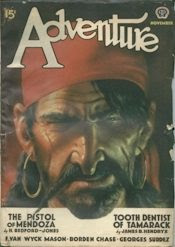 The Magazine of the Week is the November 1939 issue of Adventure magazine, cover art by Wesley Neff. Adventure was the flagship of the adventure genre of pulp magazines. Under the direction of editor Arthur Sullivant Hoffman and assistant editor Sinclair Lewis (who went on to be the first American to win the Nobel Prize for literature), Adventure became a huge success soon after its initial publication in 1910. This quickly gave rise to a great many competitors, such as Action Stories, Red Blooded Stories, Danger Trail, Dynamic Adventures, Thrilling Adventures, Mammoth Adventures, Dime Adventure, and the eloquently named Man Stories. Adventure pulps were as popular as any genre, yet unlike science fiction, mysteries, westerns, and romance, adventure fiction did not remain a separate publishing category when the industry shifted from pulps to paperbacks.
The Magazine of the Week is the November 1939 issue of Adventure magazine, cover art by Wesley Neff. Adventure was the flagship of the adventure genre of pulp magazines. Under the direction of editor Arthur Sullivant Hoffman and assistant editor Sinclair Lewis (who went on to be the first American to win the Nobel Prize for literature), Adventure became a huge success soon after its initial publication in 1910. This quickly gave rise to a great many competitors, such as Action Stories, Red Blooded Stories, Danger Trail, Dynamic Adventures, Thrilling Adventures, Mammoth Adventures, Dime Adventure, and the eloquently named Man Stories. Adventure pulps were as popular as any genre, yet unlike science fiction, mysteries, westerns, and romance, adventure fiction did not remain a separate publishing category when the industry shifted from pulps to paperbacks.Adventure and its imitators brought the most exotic locations of the world into the homes of pre-TV Americans. The plots were typically outlandish, Indiana Jones-style swashbucklers, yet Adventure was notoriously meticulous about the accuracy of factual details. This is probably why the most successful pulp writer of all, Edgar Rice Burroughs, never appeared in Adventure magazine--Adventure readers could not forgive him for placing a tiger in Africa, where there are no tigers, in the first Tarzan book.
Adventure invited readers to send in questions and retained experts in every field to answer. As a result, the letters section of Adventure is one of the most striking features of any pulp magazine. The questions to the editors in the Magazine of the Week include: How do you remove gold flour from sand? (Answer: Amalgamate the gold by adding mercury to the pan.) Any advice for navigating the Linville Gorge? (A: See that your hobnails are sharp and tight.) What is the best wood for footing arrows? (A: Genuine South American beefwood; order it from C.H. Pearson & Son Hardwood in Brooklyn.) What language is spoken in southwestern Abyssinia? (A: Amharic is the official language but Galla, spoken by the Bantu tribes, most widely used.) What is the best agent for killing and preserving very large moths and butterflies? (A: Potassium cyanide; handle with care.)
Adventure magazine had a fervently loyal fan base. It was the first pulp magazine to encourage its readers to join fan organizations, a marketing device later used successfully by the science fiction pulps. One of the fan organizations promoted by Adventure was The Legion, whose officers included Adventure editor Hoffman and Theodore Roosevelt, a devoted reader of Adventure. When the United States entered World War I, the Legion gathered information as to its members' skills and forwarded it to the War Department, which used this information in forming certain regiments. After the War, Theodore Roosevelt and other veterans in The Legion renamed the group the American Legion, and it remains an important veterans' organization to this day.
The popularity of the adventure genre dipped by the late 1930's. Adventure managed to survive until 1971, but sadly only by converting to a "slick" format girlie magazine. Even though the Magazine of the Week is a bit after Adventure's pulp heyday, I love this issue for the rugged pirate cover (not to mention the story title "Tooth Dentist of Tamarack"). We'll see another evocative, albeit politically incorrect by modern standards, Adventure cover next week.



